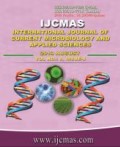


 National Academy of Agricultural Sciences (NAAS)
National Academy of Agricultural Sciences (NAAS)

|
PRINT ISSN : 2319-7692
Online ISSN : 2319-7706 Issues : 12 per year Publisher : Excellent Publishers Email : editorijcmas@gmail.com / submit@ijcmas.com Editor-in-chief: Dr.M.Prakash Index Copernicus ICV 2018: 95.39 NAAS RATING 2020: 5.38 |
A field study was conducted with an objective to assess diurnal variations in photosynthetic pigments and chlorophyll fluorescence parameters in two stay green wheat genotypes viz. DL 1266-1 and Arina 166 to gain insight into photoprotective regulation mediated by photosynthetic pigments during grain filling under late sown heat stress condition. Heat stress was imposed by delaying sowing date i.e. 12th January. Diurnal alterations in temperature affected all the parameters associated with photosynthetic pigments and chlorophyll fluorescence. Under heat stress condition, PSII maximum efficiency (maximum quantum yield of PSII) (Fv/Fm) was utmost early in the morning, afterwards it decreased up to midday and then it recovered in the late afternoon. Photosynthetic pigments (chlorophylls and carotenoids) and the minimal fluorescence (Fo), on the contrary, were low in the early morning and highest during noon time. Over the course of the sunny day, initial decrease and subsequent increases in both photochemical quenching (qP) and the efficiency of excitation capture by open PSII centers (Fv’/Fm’) were observed. However, a contrary trend was found in the changes of non-photochemical quenching (NPQ) that increased from morning to afternoon and decreased thereafter which suggested the role of xanthophyll pigments in photoprotection of photosynthetic machinery during midday hours. Genotypic diurnal varation in photosynthetic pigments and chlorophyll fluorescence parameters particularly of total chlorophyll, chla, total carotenoids, ratio of Chla: Chlb & total carotenoids: total chlorophyll and non-photochemical quenching (NPQ) were recorded sharper in DL 1266-1 as compared to Arina 166. Present study indicated that zeaxanthin cycle pigments based photoprotective mechanism is stronger in DL 1266-1 as compared to Arina 166.
 |
 |
 |
 |
 |